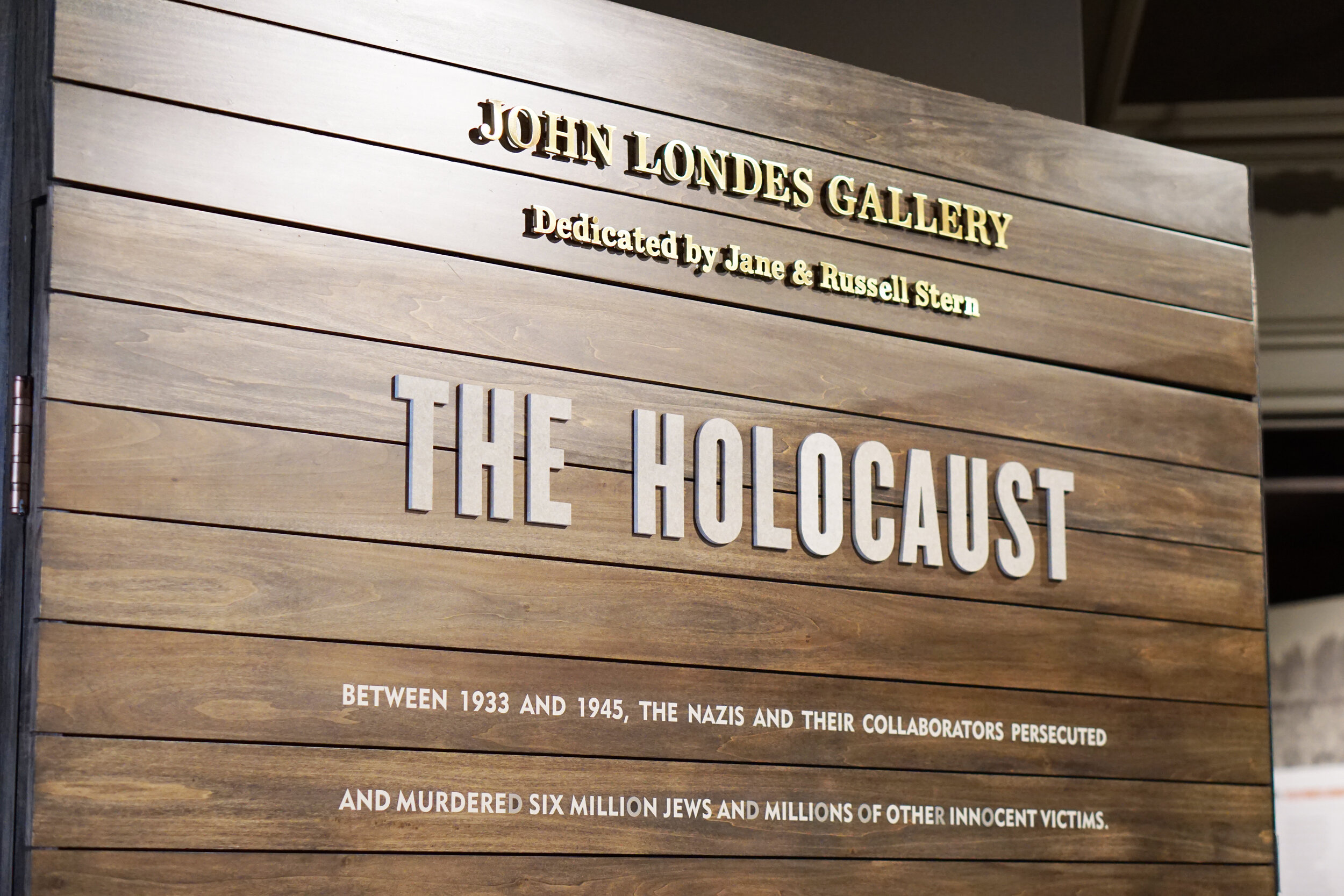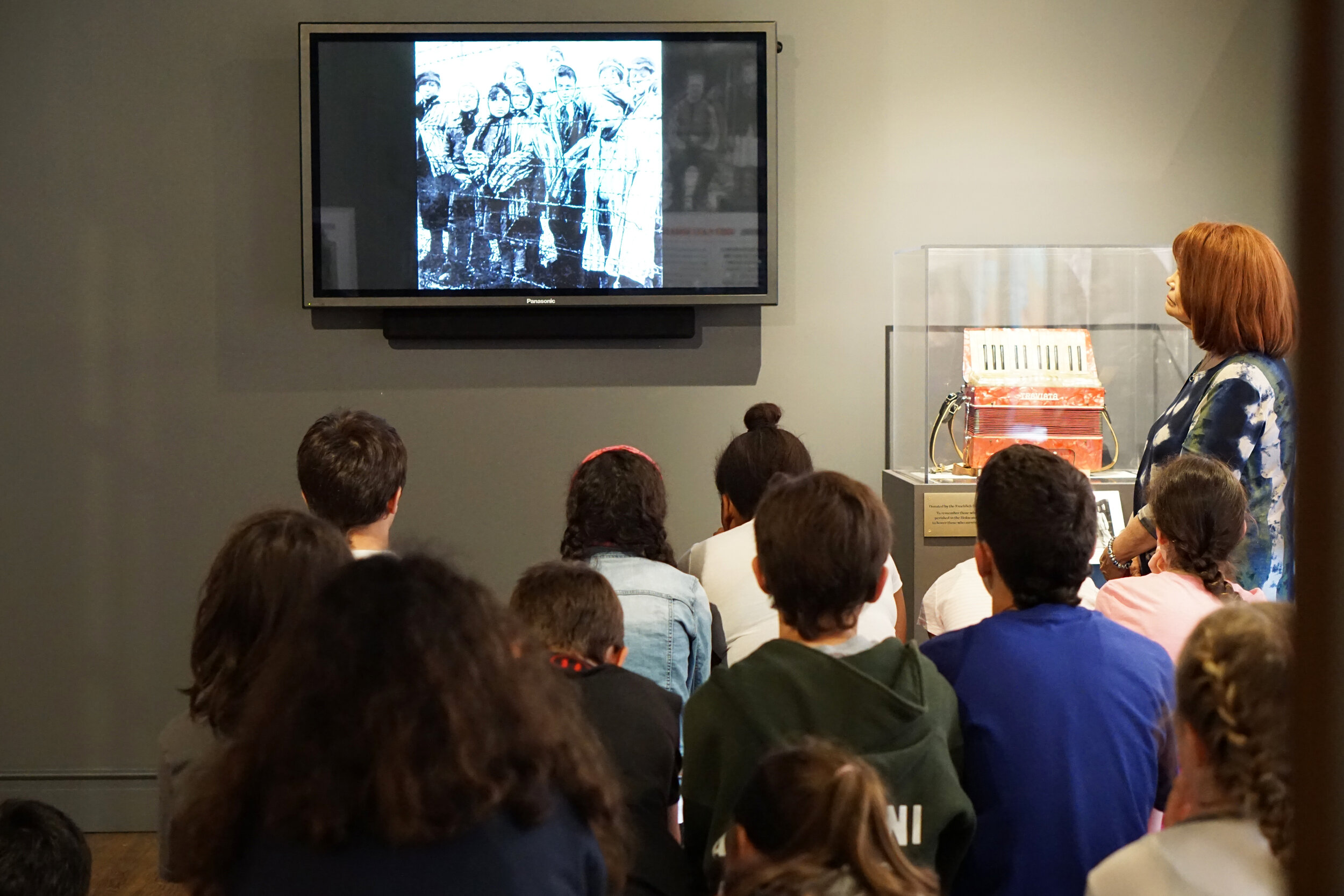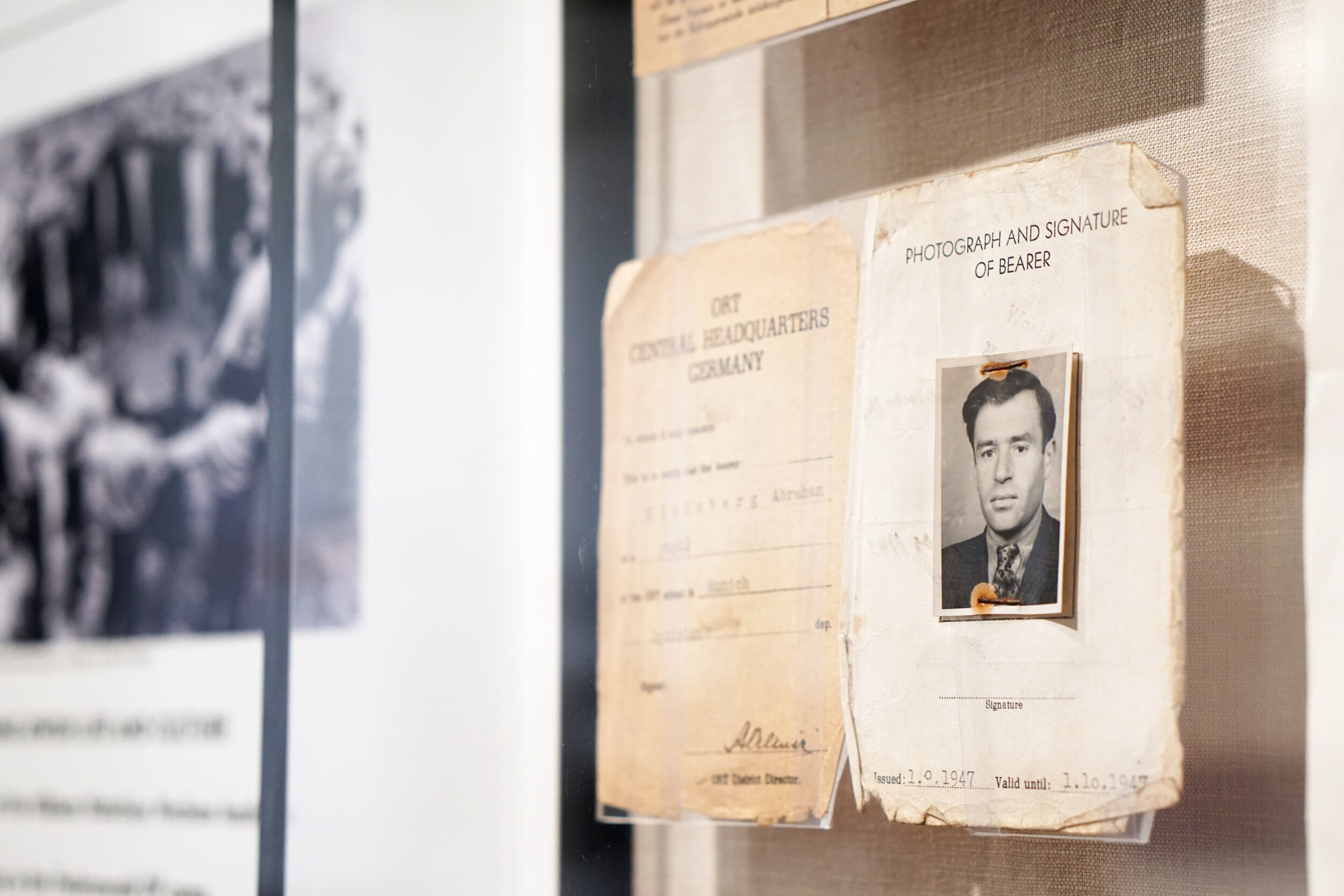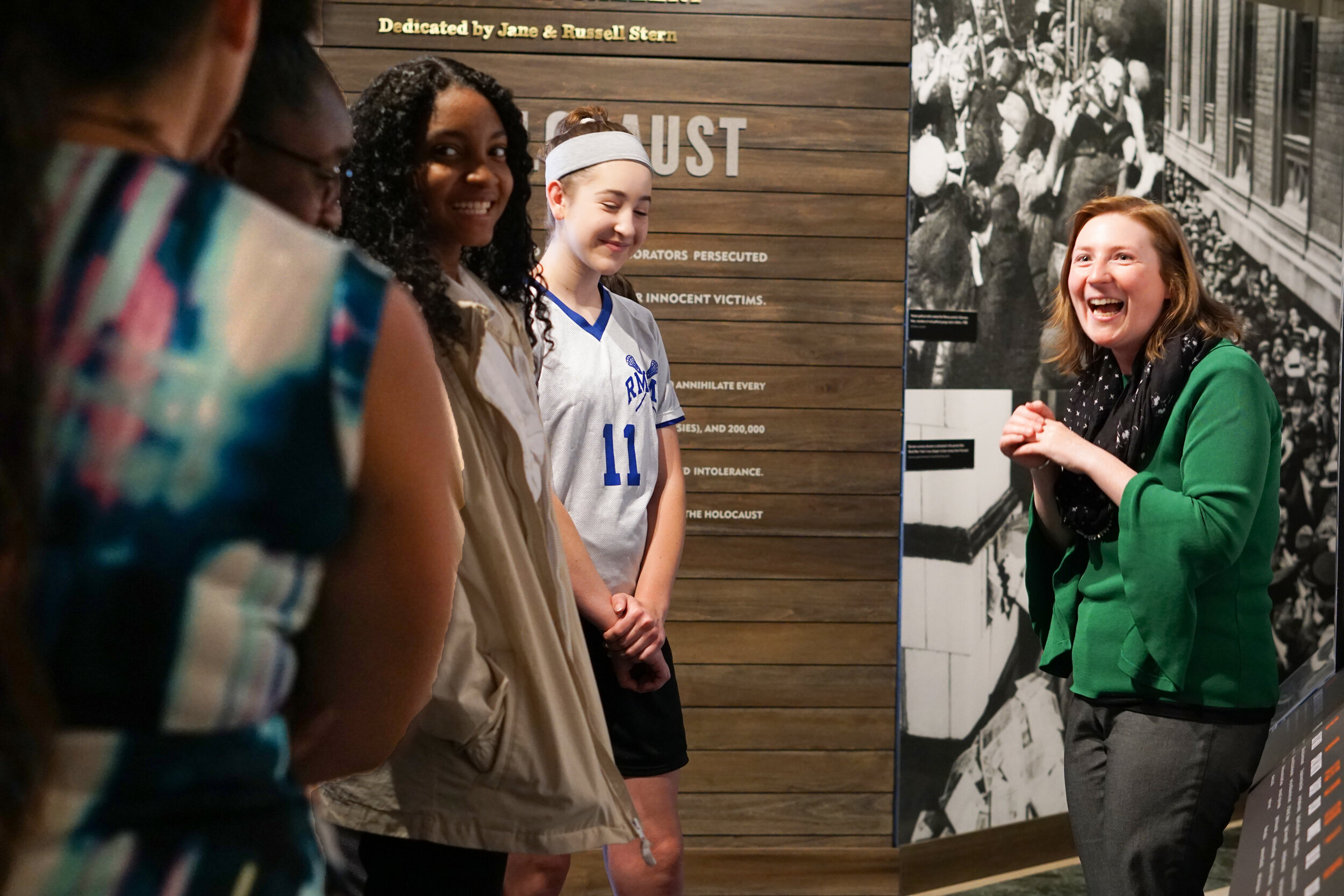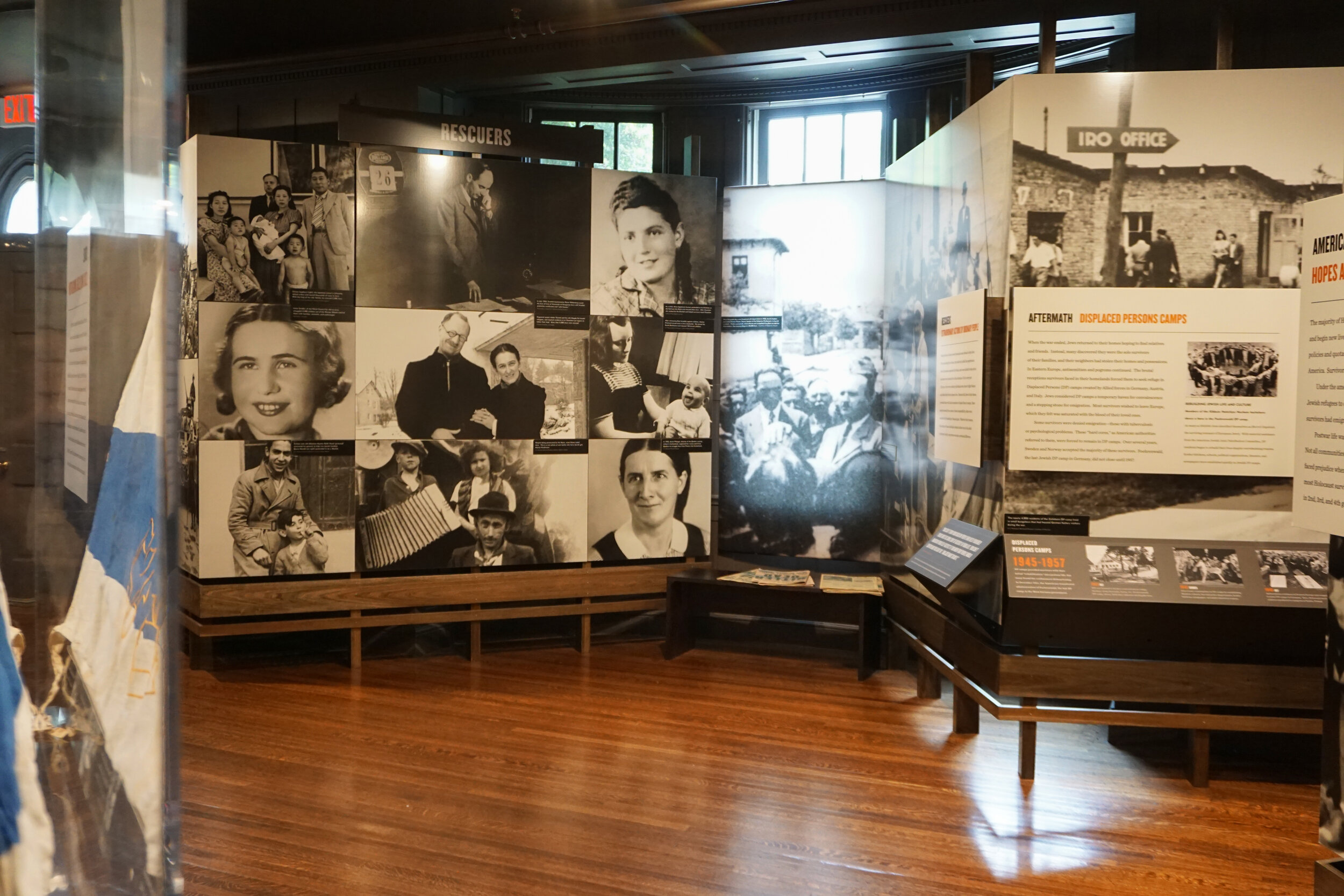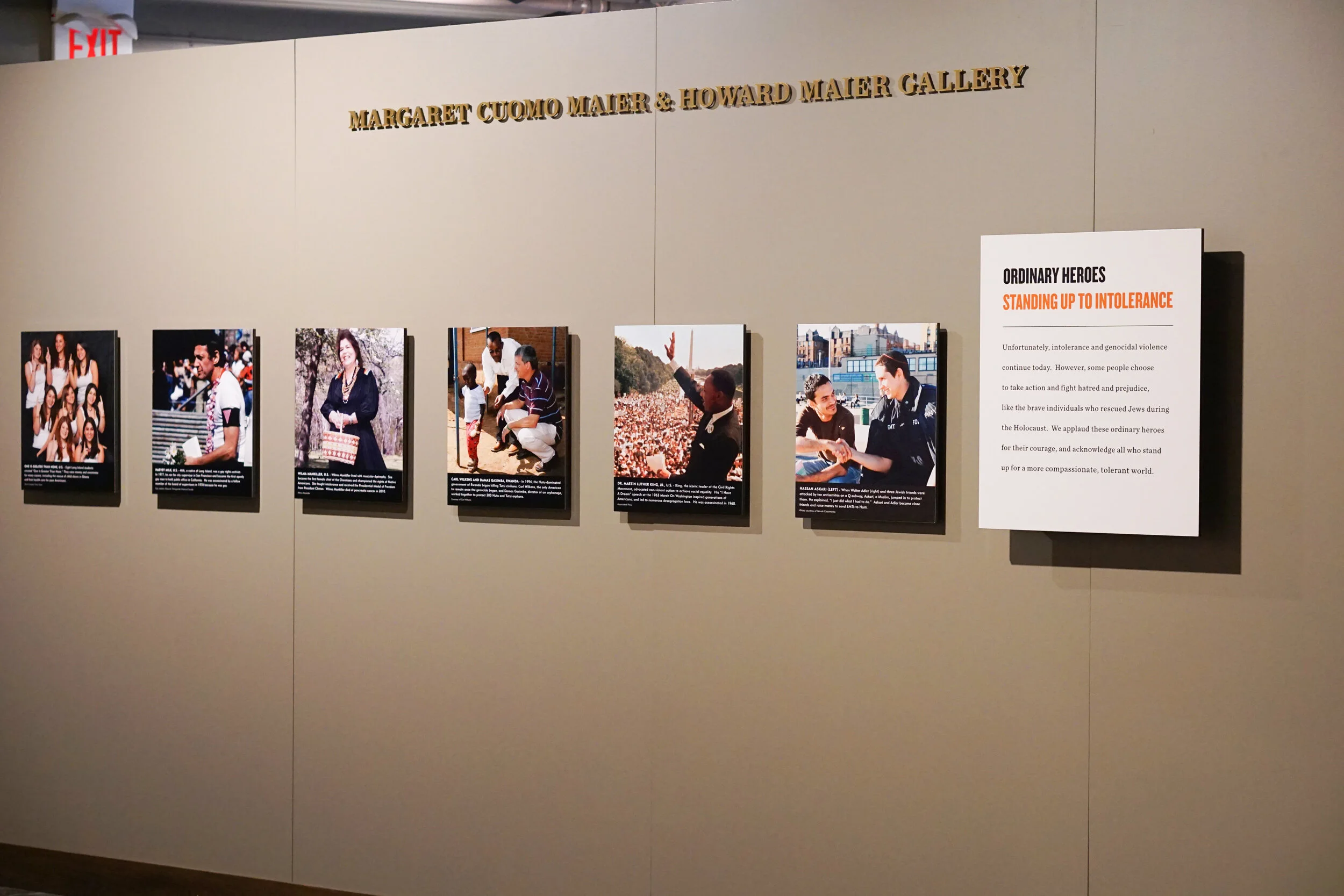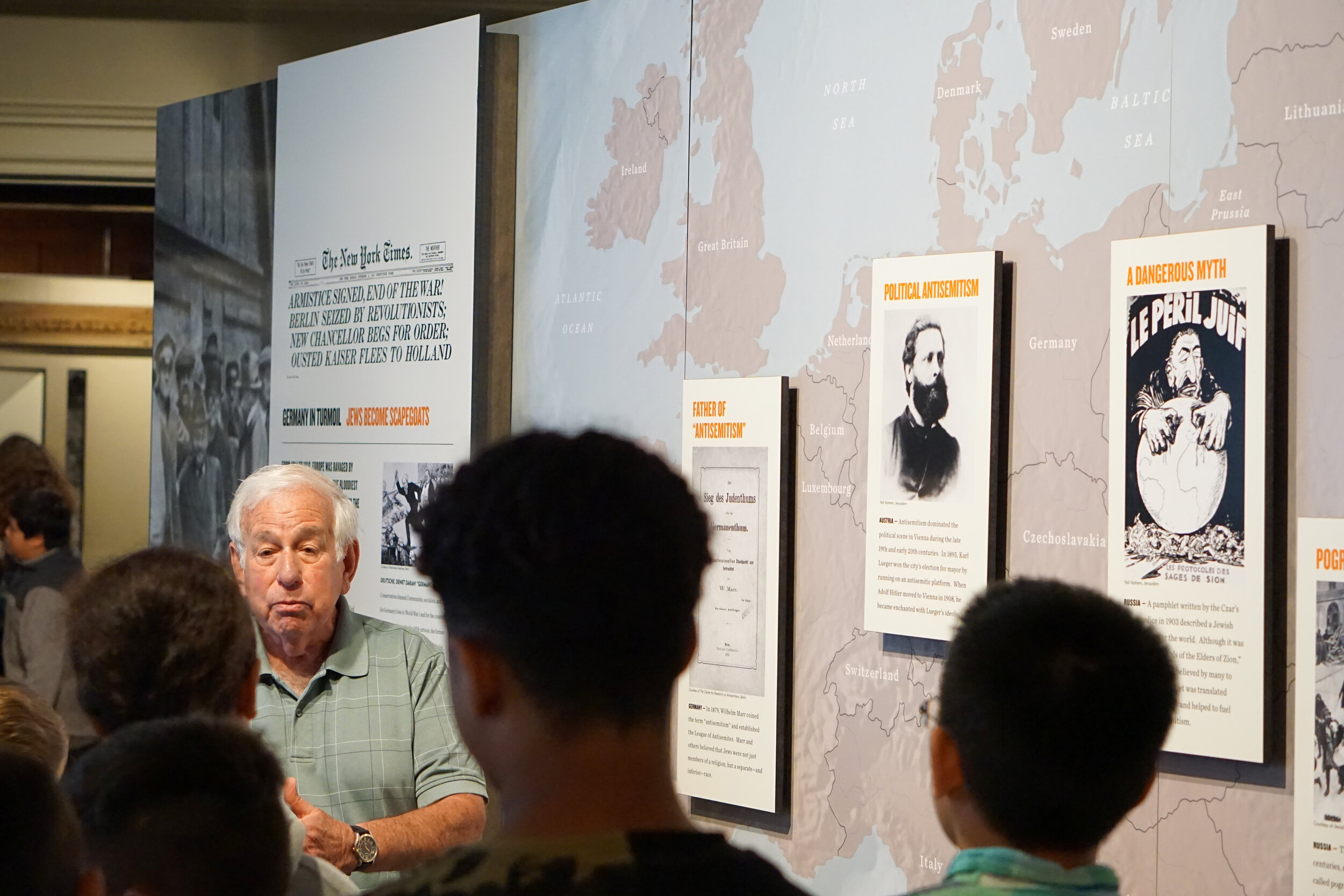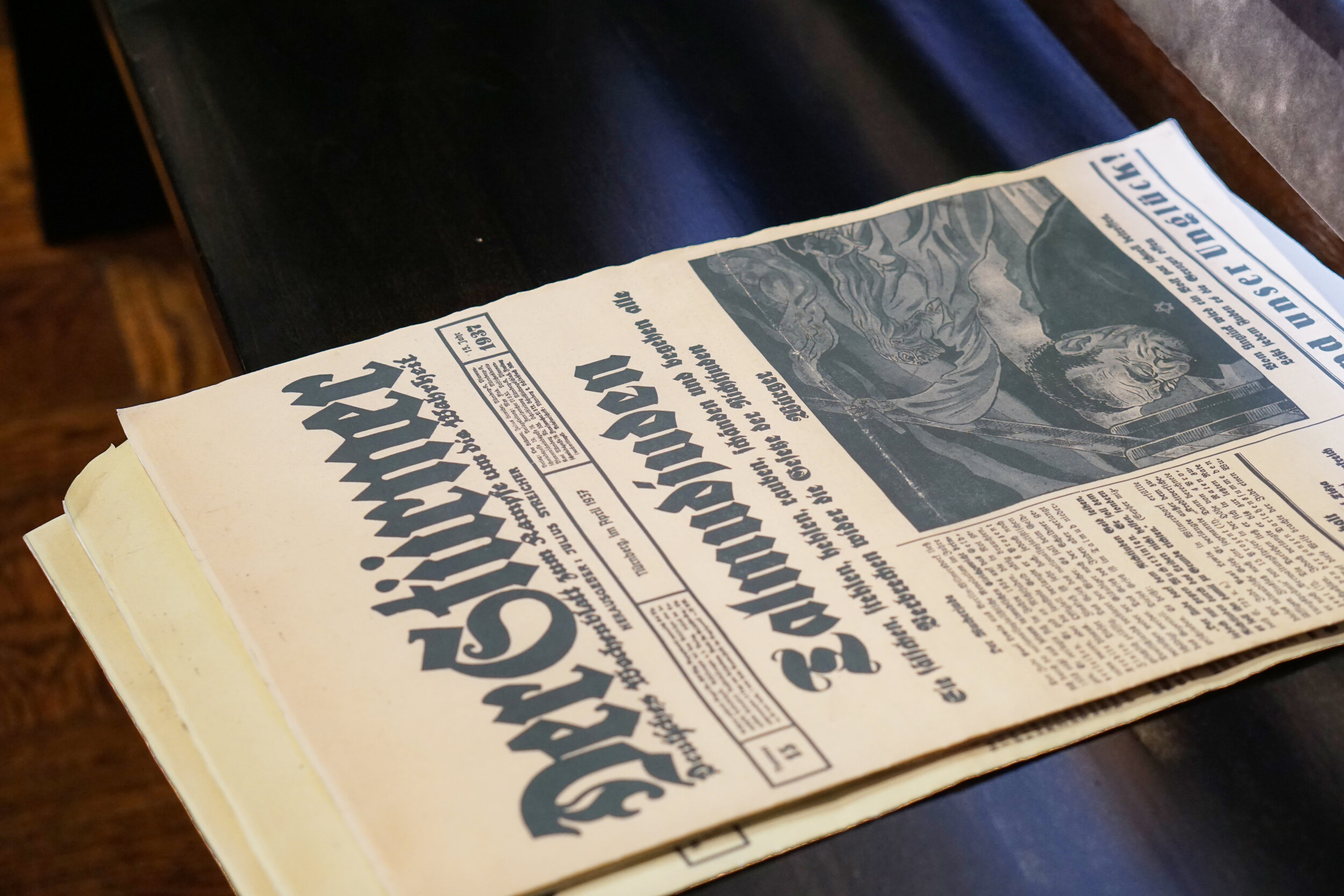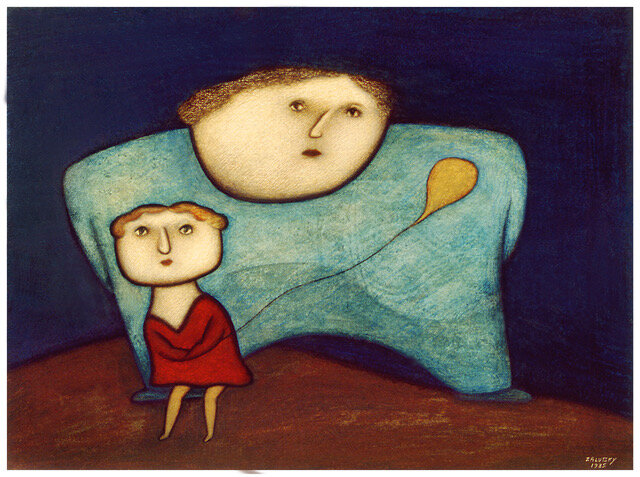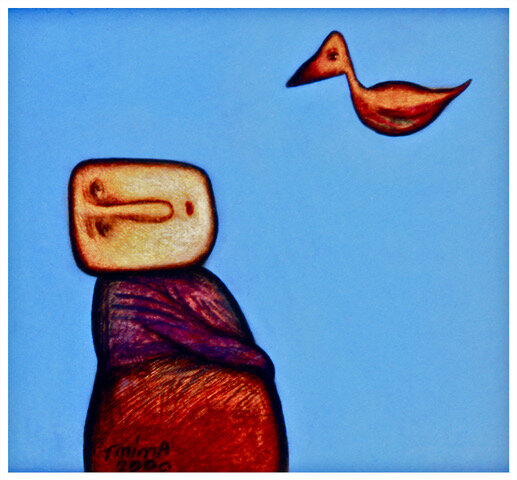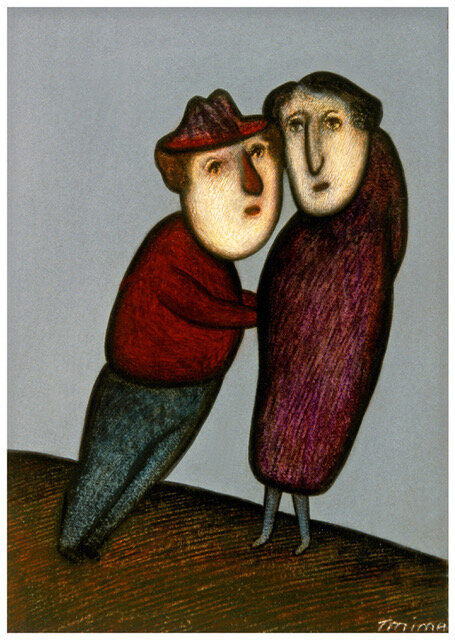PERMANENT EXHIBITION
The museum presents a detailed and comprehensive chronicle of the Holocaust in six galleries, using multimedia displays, photographs, artifacts, archival footage, and testimonies from local Survivors and Liberators. It also looks at genocides and acts of intolerance that have happened in the years since 1945, asking visitors to think about the actions an individual can take to promote resistance to prejudice and to prevent the spread of hate.
Unlike any other museum, our 3,300 square foot exhibition links this history to Nassau County, Long Island, and the communities we live in. Artifacts from individuals who moved to Long Island factor prominently in the galleries. Similarly, first-hand accounts from Survivors and Liberators from Long Island can be heard throughout the exhibition. This focus on local connections emphasizes the individual stories of tragedy and heroism.
Galleries focus on topics such as:
Portraits of European Jews Before WWII | The Rise of the Nazi Party | Lebensraum: The Occupation of Europe | The Nazi Camp System: Slavery and Murder
Death Marches: The Last Chapter of Nazism | Liberators: From Warriors to Caregivers | Displaced Person Camps | Justice after Genocide
Global and Local Intolerance Since 1945 | Ordinary Heroes Standing Up to Intolerance | Perpetrators, Bystanders, and Upstanders
SPECIAL EXHIBITIONS
On display from May 5, 2024 - July, 2024
Black and white photos. Downtrodden victims. These are the images professional photographer Daniel G. Weiss carried in his mind when he thought of the Holocaust. That was until he heard Irving Roth z”l, Holocaust survivor, first Director of Education at the Holocaust Memorial and Tolerance Center, Director of the Holocaust Resource Center (now the Irving Roth Holocaust Resource Center), address a group of students from the Reconstructionist Synagogue of the North Shore. Danny was so moved by the life force he saw radiating from Irving he immediately wanted to reach for his camera. Irving inspired Danny and today you are looking at the results.
These 18 local Holocaust survivors, who came from all over Europe, were children and young teens during the war. They went through a variety of experiences in order to survive the atrocities of the Holocaust.
What do you see?
We hope you see what we saw- their resilience and other characteristics that enabled these amazing human beings to survive and thrive. Their vibrancy, strength, sense of humor, and ability to overcome insurmountable odds shine forth. We hope you are inspired, like we were, by this visual testimony.
Everything can be taken from a man but one thing: the last of human freedoms – to choose one’s attitude in any given set of circumstances. ~ Viktor Frankl, Austrian neurologist, psychiatrist, and Holocaust survivor
THE KINDERTRANSPORT JOURNEY: MEMORY INTO HISTORY EXHIBIT
On display from November 12, 2023 - April 26, 2024
In the nine months between the pogrom of November 9, 1938 (Kristallnacht “the Night of Broken Glass”) and the start of World War II, a bold rescue operation now known as the Kindertransport brought nearly ten thousand children, most, but not all, Jewish, from Germany, Austria, Czechoslovakia, and Poland to safety in Great Britain. Much smaller numbers of children were sent to France, the Netherlands, Sweden, Switzerland, Palestine, the United States, and Australia. Most of the parents who sent them to safety perished in the Holocaust. Many of the children settled in Britain; others re-emigrated to Israel, the Americas, and elsewhere, scattering over the world. Some live today in New York and Long Island and will be speaking at the opening.
Kindertransport Survivor Robert Sugar has created a series of exhibition panels that trace these children’s epic journeys from 1938 into the 21st century. Robert fled Vienna at age six and spent the war years on the Millisle Refugee Settlement Farm in Northern Ireland. This exhibit shares the arc of Kindertransport history and details of the lives of individual Kinder and their families. It is an effort to retrieve the almost-lost story of an almost-lost generation.
To learn more about the kindertransports visit www.kindertransport.org
If Only This Jacket Could Talk
Established May 21, 2023
This exhibit provokes contemplation about what this Jewish prisoner jacket has witnessed firsthand, the horrific reality of what Jews endured in the world’s most infamous death camp, Auschwitz-Birkinau. The title of the exhibit, If Only This Jacket Could Talk, invites visitors and the tens of thousands of students who walk through the doors of the center each year, to reflect on the life of a survivor of the Holocaust as they walk through the galleries.
Visitors will be surprised at the story of how Arie Weisbrot was able to hide his jacket in his attic for over 75 years. His family is lending this incredible witness to the atrocities of the Nazi regime to our museum so that others can think about what happened less than a hundred years ago when an advanced society descended to unspeakable cruelty and committed unthinkable atrocities.
“Since opening our doors 30 years ago, the Center has asked difficult questions about the history of the Holocaust and inspired its visitors to reflect on their roles and responsibilities in society today,” said Museum Marketing Director Bernie Furshpan. “If Only This Jacket Could Talk, will challenge visitors to think about both the silence of world leaders and missed opportunities to save lives. And with the recent uptick in anti-semitic incidents, amid a larger climate of hate crimes in the U.S., it’s important now, more than ever, to inspire our young people to stand up against prejudice and advocate respect, justice, and tolerance. Educating the next generation about the lessons of The Holocaust is our moral obligation!”
Previous Exhibition: Long Island Jewish History Museum
On display from October 3, 2022 - September 8, 2023
The Holocaust Memorial and Tolerance Center of Nassau County collaborated with the Long Island Jewish History Museum, which opened its doors to the public on October 3, 2022.
The first exhibit in The Long Island Jewish History Museum, "Earning A Living: 300 Years of Jewish Businesses on Long Island" will profile over 60 businesses including farmers, manufacturers, and retailers. More than 100 artifacts will be on display that helps tell the story of how Jews financially supported their families in a variety of ways. One of the artifacts on display is Louis Cohn’s sewing machine from 1910 that has been used by four generations of the Cohn family at the Amityville Men’s Shop, a tailor and clothier that has been in business for over 110 years. Another is a stock certificate for ownership of shares in Rothman Pickle Products, an enterprise started by Joseph and Katie Rothman in East Northport in 1914.
Interesting personalities and uncommon ways of earning a living are also showcased including Harry Brause, a liquor store owner in Glen Cove beginning in 1912 who became a bootlegger during prohibition. A Roosevelt Raceway program from 1954 helps tell the story of George Morton Levy who was born in Seaford in 1888, was an attorney in Freeport, and became the founder of the harness racing track in 1940. Levy also facilitated the land transaction that brought the retailer Fortunoff from Brooklyn to open their flagship store in Westbury. A photograph of the ribbon cutting at the opening of Fortunoff in 1964 hangs in the museum.
Long Island Jewish History Museum is a project of the Jewish Historical Society of Long Island, a 501(c)(3) non-profit organization founded in 2021 to honor and celebrate Jewish history in Nassau and Suffolk counties. For more information visit www.jhsli.org.
Previous Exhibition: The Holocaust in Transnistria: Giving Voice to a Silent History
On display from June 12 - August 31, 2022
The Holocaust Memorial and Tolerance Center of Nassau County and the Holocaust Remembrance Association have worked to create a temporary exhibition that will draw attention to the largely forgotten history of the Holocaust in Transnistria. Although poorly known outside of academic circles, this 16,000 square mile region in western Ukraine between the Dniester and Bug Rivers, was home to 300,000 Jews before the war, the largest number in and around the important port city of Odesa. In June of 1941, the Nazis gave the area to its ally Romania, which soon decided to use the region of Transnistria as the destination for Jews deported from the Bessarabia, Bukovina, and the northern Moldavia regions of Romania. Altogether, Romania deported approximately 150,000 Jews to Transnistria, who joined the estimated 185,000 Ukrainian Jews who had failed to escape before the Nazi invasion. By the end of 1943, almost all of the 185,000 Ukrainian Jews had been murdered by Romanian and German soldiers. In addition, nearly 100,000 of the 150,000 Jews deported from Romania to Transnistria had been murdered or had died from exposure, starvation, or disease. The 250,000 to 280,000 Jews who were killed within the relatively small confines of Transnistria represent almost the same number as those killed in the more well-known death camp of Sobibor, and yet few people know the name of the area or the camp of Bogdanovka where 48,000 Jews were killed in only a few short weeks. This exhibition explores the history of this area and explains why it is so poorly known.
Previous Exhibition: The Holocaust Through the Eyes of a Survivor’s Daughter: Sculptures by Tmima
The Holocaust Memorial and Tolerance Center of Nassau County brought together in our museum the first exhibition of Holocaust sculptures by Tmima, a child of Holocaust Survivors, a resident of Nassau County, and a world-renowned artist. The exhibition includes 30 individual sculptures on display, showing Tmima’s process in confronting her own family history as the daughter of a Holocaust Survivor. Each piece captures the artist’s passion to remember and confront the horrors that shaped both her mother’s life and her own, exemplifying what scholars have identified as transgenerational trauma. Artwork on display at the center is available for sale. All are welcome to contact HMTC for more information via email.
Previous Exhibition: Courage to Remember
HMTC had on view The Courage to Remember exhibit, a 40-panel traveling exhibition developed by the Simon Wiesenthal Center that explores the history of the Holocaust. The exhibit has been seen on six continents by millions of people and HMTC is proud to serve as a venue on Long Island.


